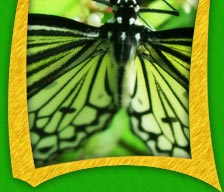|
The subject of researchers and hobbyists alike, the
spectacular butterfly has peaked the interest of many people around
the state of Florida.
|
 Photo: Emily Richardson
Photo: Emily Richardson |
THE MAJESTIC BUTTERFLY
Butterflies belong to the order of insects called Lepidoptera.
Lepidoptera means "scaled wings." Butterflies have fine scales
on their wings that look like a fine powder. These scales are coloured
and result in giving striking colours and patterns to many butterflies
while providing cryptic colours and camouflage patterns to others.
When touched by humans, the wings tend to lose some scales. If too
many scales are lost, the butterfly's ability to fly will be impaired.
The scales on the butterfly wings have many properties, mostly optical,
that interest scientists. The patterns are studied by researchers
and are seen as the best tool for understanding morphology in the
animal world. Morphology is the study of the how shapes, sizes and
colors of specific organisms evolve.
The average life span of a butterfly is only about
two to three weeks, but it can be as brief as one to two days or
as long as a year. They are generally attracted to brightly colored,
simple flowers. Most adult butterflies found in Florida feed on nectar
from flowering plants.
|
 Photo: Emily Richardson
Photo: Emily Richardson |
LIFE CYCLE
The butterfly has a four stage life cycle in which it morphs into
different forms. The four stages include the egg, larva, pupa, and
adult butterfly stages.
Egg
The female butterfly has about 100 eggs
inside her. The male will fertilize the eggs and when the female
is ready she will deposit her eggs onto a leaf. During the first
stage, butterfly and moth eggs vary greatly in size between species,
but they are all either spherical or oval.
Larva
The second stage is called the larval
stage. The larvae, otherwise known as the catepillars, emerge from
the eggs. They consume plant leaves and spend practically all of
their time in search of food. After time they undergo several
stages of molting in which they begin to develop wing patterns.
Pupa
When the caterpillar exceeds a minimum
weight at a particular time of day, it will stop feeding
and begin "wandering" in
a quest for a suitable pupation site, usually the underside
of a leaf. The larva transforms into a pupa (chrysalis), which
then transforms into a butterfly by metamorphosis.
Adult Butterfly
The adult
stage of the insect is known as the imago. Butterflies have four
wings that are covered with tiny scales, and six legs. After it
emerges from its pupal stage, it cannot fly for some time, because
its wings have not yet unfolded. A newly-emerged butterfly needs
to spend some time 'inflating' its wings with blood and letting them
dry, during which time it is extremely vulnerable to predators.
|
 Photo: Emily Richardson
Photo: Emily Richardson |
BUTTERFLY BEHAVIORS
Basking:
Butterflies are cold-blooded. Therefore,
they rely on heat absorbed from the sun. They usually will sit out
in a patch of sunlight and outstretch their wings. This behavior
allows them to catch the sun’s
rays and heat up their bodies. They can raise their internal temperature
higher than the temperature around them This need to absorb heat
from their environment is the reason why so many butterflies have
darkly colored bodies.
Feeding:
Butterflies eat by sipping liquids, usually nectar
from flowering plants. They do this by uncurling their proboscis
found on the lower side of their head. The proboscis looks and acts
like a straw which can be inserted deep into the tubes of the flower.
Then the butterfly begins sipping away on delicious sweet nectar.
Resources for this article provided by Wikipedia & butterfliesandmoths.org (Opler,
Paul A., Harry Pavulaan, Ray E. Stanford, Michael Pogue, coordinators.
2006. Butterflies and Moths of North America. Bozeman, MT: Mountain
Prairie Information Node.)
|












